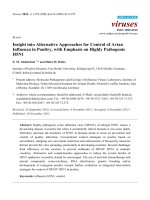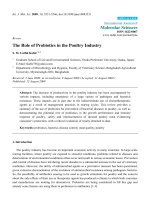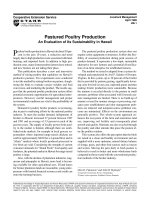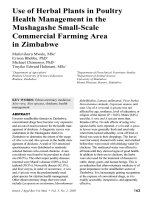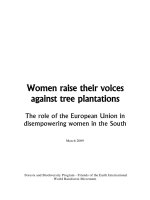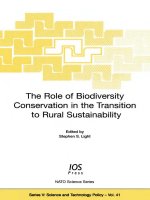The Role of the Intensive Poultry Production Industry in the Spread of Avian Influenza pptx
Bạn đang xem bản rút gọn của tài liệu. Xem và tải ngay bản đầy đủ của tài liệu tại đây (157.98 KB, 16 trang )
1
The Role of the Intensive
Poultry Production
Industry in the Spread of
Avian Influenza
A report by Compassion in
World Farming
February 2007
2
Executive summary
Wild birds have taken much of the blame for the spread of H5N1 across the world
but this report by Compassion in World Farming unveils evidence showing that the
development of highly pathogenic strains of bird flu lies at the door of factory
farming.
The past two decades have seen a complete transformation in the poultry industry
with a 300% increase in production across the world. This increase is, by and large,
thanks to reliance on intensive farms and a transnational production system. Poultry
production is now a global affair.
An intensive poultry farm provides the optimum conditions for viral mutation and
transmission - thousands of birds crowded together in a closed, warm and dusty
environment is highly conducive to the transmission of a contagious disease.
Selecting generation after generation of birds for their faster growth rates and higher
meat yields has left the birds’ immune systems less able to cope with infections and
there is a high degree of genetic uniformity in the population, making spread of the
virus all the more easy.
Further intensification of the industry has been suggested by some as the solution to
avian flu, on the rationale that keeping birds indoors will prevent contamination.
However, this relies on perfect, fail-safe biosecurity – and such measures are near
impossible to implement.
Movement between farms of people, materials and vehicles poses a threat and
breaches in biosecurity are inevitable.
Intensive farming is creating highly virulent avian ‘flu strains. When we factor in the
frequent flow of goods within and between countries, the potential for disease spread
is high.
Compassion in World Farming believes that current and proposed H5N1 control
measures are not based on the best available evidence, and is calling for an enquiry
into the role of the global, intensive poultry industry in the spread of highly
pathogenic avian influenza.
Whilst not denying that wild birds, backyard and free range farms naturally play a
role in the spread of the current epidemic, continuing to focus containment measures
on poultry is misguided and ignores the overwhelming evidence pointing towards
other often more important routes of spread - namely the global trade in live poultry
and poultry products. The spread of H5N1 from China to Europe, Africa and the
Middle East correlates with major road and rail routes rather than bird migratory
routes or seasons.
Keeping massive numbers of poultry on intensive farms worldwide is now coming
back to bite us. The solution lies in bringing an end to factory farming and the
conditions that can act as a disease pressure cooker, instead rearing animals using
humane and sustainable farming methods.
3
The Role of the Intensive Poultry Production Industry in the
Spread of Avian Influenza
Avian influenza is here to stay. It has been always been around, and always co-
existed with its host species - wild birds - without great cause for concern. Today we
see it jumping across to domestic birds over and over again, killing whole flocks
within days. While wild birds are being blamed for the outbreaks, free range farms
are considered the biggest risk because of the potential contact between domestic
and wild birds. Yet, wild birds have always carried avian influenza viruses. They have
always migrated and had contact with backyard domestic poultry. There is a long
history of occasional transmission of the virus across to chickens, causing mild
outbreaks of disease.
In the last ten years, however, the incidence of highly pathogenic strains of avian
influenza has increased dramatically (Nguyen et al. 2005). These strains are different
– they spread throughout the bird’s whole body, can kill it within 24-48 hours
(Center of Excellence DMHA 2006), and they can also be fatal to humans.
The crux of the issue is: what has changed in the last ten years to cause this new
development?
HPAIs and LPAIs – What are they, where do they come from & how are they
dangerous?
Avian Influenza viruses are extremely common in nature. Although many wild birds
may harbour influenza viruses, they are found most commonly in wetland birds and
birds from aquatic environments, such as ducks, geese, swans, gulls and waders
(Olsen et al. 2006). These birds carry the low pathogenicity strains of avian influenza
(LPAIs); these can occasionally cross over to domestic poultry such as chickens and
turkeys and cause mild disease, but they do not seem to pose a significant risk to
humans who become infected.
All influenza viruses have a propensity to change and generate novel agents
(Webster 2004). When they infect domestic poultry, the low pathogenicity strains
(LPAIs) can evolve and change to become much more virulent highly pathogenic
avian influenza strains (HPAI). These strains cause a fatal systemic infection in
poultry (i.e. an infection that spreads all over the body) and they are extremely
contagious.
There are several subtypes of both LPAIs and HPAIs. The subtype that is currently
making its way around the world is HP (highly pathogenic) H5N1. This virus is highly
pathogenic for humans as well as poultry, although so far it cannot spread easily
between humans as H5N1 infects cells that are far enough down the respiratory tract
that the virus is not easily expelled by coughing (Normile 2006a). To date, H5N1
has only affected those that have come into close contact with infected poultry and
not those in contact with infected humans.
Very brief history of the virus
4
In recent history, H5N1 first appeared in 1997 in Hong Kong’s wet markets (live bird
markets) and chicken farms. Its spread was contained in Hong Kong at that point
following the culling of all poultry in the region. In 2003 the same virus resurfaced -
suggesting it had never been eradicated - and spread relentlessly across East Asia,
decimating the poultry population. In 2005, an outbreak in migratory wild birds in
Qinghai Lake, China killed 6000 birds (Normile 2006b). The virus has since spread
across countries in Asia, Europe, the Middle East, as well as some African countries.
It has been found in chicken and turkey farms and in some wild birds, mainly swans
and geese. As of 2005, the epidemic had caused the death of over 100 million birds
(Normile 2005). To date, it has infected 271 humans, with 165 deaths (WHO 2007).
The world is focusing on wild birds - and therefore on free range farms
Much of the blame for the spread of the virus across the world has been placed on
wild birds. Because poultry on free range and backyard farms could potentially come
into contact with wild birds or their droppings, these farming types are an obvious
target for blame. Many countries have periodically ordered their free range flocks
indoors - among them France, Germany, the Netherlands, Sweden, Slovenia, and
parts of Canada and Norway.
A further intensification of the poultry industry has been put forward as the solution
to the problem, on the rationale that keeping birds indoors in confined spaces will
prevent contamination with the virus and halt virus spread. The Food and Agriculture
Organization (FAO) and the World Organization for Animal Health (OIE) have stated
that:
“…a more focused approach to HPAI control can be mounted to progressively
eradicate the disease…For the long term success of this strategy, restructuring of the
poultry sectors in the region will need to be seriously considered. (…) There are
substantial opportunities for economic growth, particular in rural areas, to be fuelled
by this …‘Livestock Revolution’” (FAO and OIE 2005)
By ‘Livestock Revolution’ one should read further intensification of poultry
production. Is there any evidence that a ‘Livestock Revolution’ would help control the
problem of repeated HPAI outbreaks in domestic poultry?
Wild birds should not be seen as the main vector
Whilst wild birds may have played a role in the spread of H5N1, they are far from
being the main culprits. Following the discovery of H5N1-infected migrating wild
birds in Qinghai Lake, China in 2005, migrating wild birds were assumed to be the
key responsible agents for carrying the virus across to Europe, Africa and the Middle
East. However, the geographic spread of the disease correlates with major road and
rail routes rather than migratory routes or seasons (The Lancet Infectious Diseases
2006).
Furthermore, recent molecular and phylogenetic analysis of H5N1 has found that
different geographical regions have distinct genetic sublineages of the virus in
circulation (Chen et al. 2006). This suggests the virus is perpetuated through the
movement of poultry and poultry products, rather than by continued reintroduction
by migrating wild birds (ibid.). If migratory birds had repeatedly introduced the virus
into poultry, we would expect there to be fewer regional differences in the virus
5
(Normile 2006b). Although it is true that a few healthy wild birds have been found
carrying the virus (Chen et al. 2006), the overwhelming majority of wild birds found
infected with H5N1 virus were dead - which suggests that the virus is as pathogenic
for most wild birds as it is for poultry. This would of course prevent them from
carrying the virus over long distances. In fact, there are no known reservoirs of any
HPAI in the wild, which again suggests high levels of pathogenicity in wild birds
(Melville and Shortridge 2004).
Professor Kennedy Shortridge, a leading flu expert, recently commented that:
"There's a railway line that runs from… one side of Qinghai Lake and there's a road
that goes to the other side. If you look at the movements of H5N1, they don't seem
to tie in with migratory bird routes for the simple reason they seem to follow the
Trans-Siberian railway." "Lots of people don't realize that there's movement of
poultry from one country to another, even to Nigeria, where we've got bird flu.
People are transporting all sorts of poultry meat." (Lyn 2006).
There is also a fish farm in the vicinity of Qinghai Lake; in integrated fish farms in
Asia, faecal waste from poultry farms is dropped directly into ponds as food and
fertilizer (GRAIN 2006). The faeces of infected poultry carries a very high viral load
and Stallknecht et al. (1990) proved that avian ‘flu viruses can survive in water for
longer in colder conditions – remaining infective for up to 102 days at 28°C and for
up to 207 days at 17°C.
In a recent Science paper, Olsen et al. (2006) state that ‘it is clear that the H5N1
problem originated from outbreaks in poultry, and that … their geographical spread
probably cannot be stopped without implementation of proper control measures in
the global poultry industry’.
It is also clear that many cases of wild bird infections seem to have occurred when
the wild birds were in close proximity to captive birds (Hong Kong Agriculture,
Fisheries and Conservation Department in Melville and Shortridge 2004, Chen et al.
2006). In fact, genetic sequencing of virus isolated from infected wild birds at
Poyang Lake found that the birds were likely infected by local poultry while over-
wintering in southern China (Chen et al. 2006).
The available evidence thus points to wild birds being, by and large, victims of the
spread of H5N1.
Trade
The poultry trade – both legal and illegal - is a major potential vector for the spread
of H5N1. Many experts see trade as the major cause of the spread of avian ‘flu,
through infected bird droppings on shells, crates and other surfaces (Nature 2006).
Dr Leon Bennun from BirdLife International points out that
“what is striking is that countries like Japan and South Korea, which imposed strict
controls on the import and movement of domestic poultry after initial outbreaks,
have suffered no further infections… In fact, countries which have not yet developed
a large-scale intensive poultry industry have also been largely spared… Factor in the
global nature of the poultry industry, and the international movement of live poultry
6
and poultry products both before and after the Asian outbreaks, and we have the
most plausible mechanism for the spread of the virus between places which are not
connected by the flyways of migratory birds…The timing and pattern of outbreaks
has been largely inconsistent with wild bird movements; but they have often
followed major trade routes” (Bennun 2006).
Legal trade
There are a few documented cases of legal shipments infected with H5N1. An
outbreak of H5N1 among poultry in Tibet in January 2004 was traced to a shipment
of chickens from China (Normile 2005). H5N1 was also detected in duck meat
imported into Korea from China (Tumpey et al. 2002 in Mase et al. 2005). Mase et
al. (2005) report on a case where duck meat legally imported into Japan from China
in 2003 was found to be infected with H5N1 during a routine, random-sampling
surveillance procedure. This suggests that even in countries where surveillance
procedures are practiced, there is still a risk that the virus could be introduced via
legal trade routes. As an illuminating figure, the European Union imported 514,719
live chickens and ducks in 2004 (FAO Stats). China exports large numbers of live
chickens and ducks, although the number of exports has declined dramatically since
outbreaks of H5N1 avian influenza started. Even during 2003, when outbreaks of
the virus were erupting in Asia, China exported 42,584 live chickens & ducks (FAO
Stat 2006).
Exports of live chicken and ducks from China 1980-2004
10000
15000
20000
25000
30000
35000
40000
45000
50000
55000
19
8
0
19
81
1982
19
8
3
19
84
1985
19
8
6
19
87
1988
19
8
9
19
90
1991
19
92
1
9
93
19
9
4
19
95
1
9
96
1997
19
98
1
9
99
2000
20
01
2
0
02
2003
20
04
Year
Illegal Trade
7
Illegal poultry movements are likely to be another important route of spread. The
value of the illegal poultry trade is thought to be superseded in value only by that of
narcotics and arms (Nature 2006). To cite a few documented examples:
- In November 2005, an illegal consignment of chicken shipped from China
was intercepted by the Food Standards Agency in the UK (Lawrence 2005).
Upon raiding the meat wholesalers Eurofreeze - the intended destination for
the shipment - the authorities found other illegally labeled meats, as well as
fraudulent health marks for large, reputable companies in Ireland, Holland,
Spain and Germany. Although the FSA declined to divulge it, the list of EU
companies that had bought supplies from Eurofreeze ran several pages long.
- In September 2005 customs inspectors at the US Department of Agriculture
found an illegal shipment of 98,400 chicken eggs at a port in California
(Nature 2006). Scott Saner, of the USDA’s Smuggling, Interdiction and Trade
Compliance Program, said in an interview to the press, “There are a lot of
these containers coming in every day, and the resources are very limited as
to how many of them can be looked at. So there is stuff that will get
through” (Lambrecht 2005).
- In October 2004 authorities at Brussels International airport seized two Thai
eagles infected with H5N1, carried in a passenger’s hand luggage; the birds
had been ordered by a Belgian falconer, who already owned four other birds
of the same species (Van Borm et al. 2005).
Laos – a country case study:
The poultry industry in Laos is made up predominantly of small holders, raising free
range chickens for domestic consumption, or to be sold locally. Local breeds account
for 87% of poultry production, with commercial breeds of broilers and layers being
restricted to commercial farms (USDA Foreign Agricultural Service 2005).
Laos suffered an outbreak of HPAI H5N1 in 2004. Forty two of the 45 confirmed
outbreaks occurred on commercial broiler and layer farms. The remaining three
outbreaks were in smallholder flocks located near to infected commercial enterprises
(ibid.).
8
If wild birds and free range farms are the main risks in the spread of H5N1, how did
a country of backyard farms, in the middle of the worst affected zone, see 93% of its
outbreaks concentrated in intensive farms? Interestingly, in Laos there is next to no
contact between ‘backyard’ farms and the intensive production farms of the capital;
the capital’s intensive farms, on the other hand, are commonly integrated into
foreign poultry companies (GRAIN 2006).
It is useful to compare the Laos case with those of neighbouring countries Thailand
and Vietnam, which are two of the worst affected countries. In Thailand and
Vietnam, there is far more integration and contact between commercial operations
and smallholders - smallholders are often supplied with chicks and feed by
commercial enterprises (GRAIN 2006).
Patterns of change in the poultry industry
The past two decades have seen a complete transformation in the poultry industry.
Poultry production across the world has increased by just over 300%. China, the
source of HPAI H5N1, has seen an increase in poultry production of almost 900%
since 1980. Indonesia, Thailand and Vietnam have seen increases of approximately
700%, 300% and 400%, respectively (all statistics from FAO Stats).
9
Growth in poultry production in China in the last 15 years
(in Metric Tons)
0
1000000
2000000
3000000
4000000
5000000
6000000
7000000
8000000
9000000
10000000
11000000
12000000
13000000
14000000
15000000
16000000
19
8
0
1982
1
9
84
19
8
6
1988
1
9
90
19
92
1994
1
9
96
1
9
98
2000
2002
2
0
04
Year
Annual Production (Mt)
Growth in poultry production in Indonesia,
Thailand and Vietnam 1980-2005
(in Metric Tons)
0
300000
600000
900000
1200000
1500000
19
8
0
19
8
3
1
986
19
8
9
19
9
2
1995
19
9
8
20
0
1
2
00
4
Year
Annual Production
(Mt)
Indonesia
Thailand
Viet Nam
The great majority of the new poultry production is happening on intensive farms
integrated into transnational production systems (Hans Wagner of the FAO in GRAIN
2006). Poultry production is now largely an integrated global affair. For example,
Thai company Charoen Pokphand (CP) is Asia’s biggest producer of poultry and
poultry feed, calling itself ‘the kitchen of the world’. CP have previously supplied
Tesco, the largest UK supermarket chain; they are the biggest supplier of meat
chicks in China and in Indonesia, where they also dominate the chicken feed
industry; and they control half the intensive poultry sector in Vietnam (GRAIN 2006).
10
In CP’s own words “The broiler breeder farms supply nearby hatcheries, which have
an annual capacity of 2 million chicks per week. The broiler farms supply 330,000
chickens per day to the 64,000 square meters slaughterhouse and processing plant,
which, when it hits full-capacity in mid -June, will produce 60,000 tons of processed
and cooked chicken a year.” (from www.cpthailand.com
).
This is the ‘Livestock Revolution’ to which FAO and WHO referred. However, there is
no evidence that continuing to intensify poultry production would solve the problem
of high incidence of HPAIs in the poultry sector. It is much more likely that doing so
would perpetuate or exacerbate the problem and could increase the likelihood of a
new strain emerging that could efficiently spread throughout the human population.
Intensive farming and Avian ‘Flu Viruses
“It is high-density chicken farming that gives rise to high-virulent influenza viruses."
Professor Earl Brown (Bueckert 2004 in Greger 2006)
In the words of University of Ottawa virologist, Earl Brown, "If you get a virus into a
high-density poultry operation and give it a period of time… then you turn that virus
into a highly virulent virus. That's what always happens." (Bueckert 2004 in Greger
2006). One such process seems to have been started during an outbreak of LPAI
H7N3 in April 2006 on three farms in Norfolk, UK. According to a report by DEFRA
(the Department for Environment, Food and Rural Affairs) “there is some evidence
that the virus may have increased in virulence from the first known affected flock to
the third affected flock, which was under separate ownership. This is based on the
mortality rates, which doubled on the first farm, trebled on the second farm, and
increased fourfold on the third infected farm. Also the prevalence of serologically
positive animals on the second farm was only 45% after a period of 28 days…This is
in comparison to a prevalence of 100% after 12 days of infection in the third flock”
(DEFRA 2006).
An LPAI in a wild bird is not dangerous – an LPAI in an intensive farm is…
Once an influenza virus invades a commercial poultry farm, it has an optimum
number of susceptible poultry for rapid viral evolution (Webster and Hulse 2004). In
intensive production systems, the density of animals is very high – for broiler meat
chickens, this means between 11 and 25 birds per square meter in the EU (SCAHAW
2000). The animals are packed together in a closed environment. As the days
progress, birds end up standing on a cake of faeces, feathers and sawdust, in a
dusty, warm atmosphere – an environment perfect for the transmission of a
contagious disease. Additionally, the commercial breeds of chicken used in intensive
production have undergone intensive selection for fast growth rate and high meat
yield; there is evidence that this process has also reduced their immunity to disease
(Rauw et al. 1998). Intensive selective breeding also results in genetic uniformity in
the population (Delany 2003), making spread of the virus all the more easy.
The evolution towards higher virulence occurs through changes in the surface of the
virus - more specifically, through changes in a protein called haemagluttinin (the ‘H’
in H5N1) (Swayne and Suarez 2000). Avian Influenza viruses lack ‘proof-reading’
mechanisms and are therefore unable to repair errors that occur during replication
(Webby et al. 2000 in Webster and Hulse 2004) - this means that the virus
11
continuously accumulates mutations as it reproduces. The more animals that are
kept together in a confined space, the higher the virus load generated and
consequently, the faster changes in the virus can occur. In time, the result is the
emergence of a highly virulent strain of the virus - an HPAI such as H5N1.
There are several documented cases of an LPAI evolving into an HPAI after
introduction into an intensive farm – in Italy (1999), in Chile (2002), in the
Netherlands (2003) and in British Columbia, Canada (2004) (Mannelli et al. 2006,
Rojas et al. 2002 in Webster and Hulse 2004, Velkers et al. 2006, Webster and Hulse
2004). For both the Italian and Dutch cases there is genetic evidence linking the
source LPAI virus to the ensuing HPAI strain (Banks et al. 2001, Velkers et al. 2006).
Also, as mentioned previously, the first stages of evolution towards higher virulence
were documented by DEFRA for the LPAI H7N3 outbreak in Norfolk (DEFRA 2006).
What makes the current HPAI H5N1 strain different from other avian influenza
outbreaks is that whilst other strains have arisen and been contained and eradicated
within a period of time, H5N1 has been circulating in Asia since 1996 (Sims et al.
2005). In scientific terms, it has become endemic in the region and it will therefore
surface over and over again, with no realistic prospects of eradication in the short to
medium term (Sims et al. 2005). In this context, we acknowledge that the
separation of wild and domestic birds (as well as separation of domestic ducks/
geese and domestic chickens) is likely to be an important containment measure in
South East Asia, where the virus has become endemic. This is particularly
important, as there is evidence that ducks can carry the virus asymptomatically
(Chen et al. 2006).
The myth of biosecurity
Intensification of poultry production, accompanied by increased biosecurity, has been
repeatedly suggested as the solution to the recurring avian influenza problem.
However, biosecurity measures have repeatedly failed and outbreaks have occurred
on intensive production farms. It is appropriate to point out that the Norfolk H7N3
outbreak referred to above was attributed to a breach in biosecurity - infected faeces
was carried into the shed on the boots of a worker. In a case study of a HPAI
outbreak in the Netherlands in 2003, layer farms were more at risk of infection than
intensive units. It was suggested that this was due to contamination between farms
via cardboard egg trays (Thomas et al. 2005).
The truth is that perfect biosecurity is a myth - movement between farms of people,
materials and vehicles will inevitably pose a threat and the inevitable breaches in
biosecurity can have serious consequences. It is clear that intensive farming provides
the ideal environment for generation of highly virulent avian ‘flu strains. When we
factor in the frequent flow of goods within and between countries, the potential for
disease spread is high (Brown 2004).
Food for the future?
The rapidly expanding demand for animal protein in both developing and developed
countries can only exacerbate the current situation. The expanding poultry
production industry increases the opportunity for zoonotic transmission (Webster
2004). As there is only limited space available for farming purposes, the heightened
12
demand for animal protein will result in more animals being farmed ever more
intensively. Furthermore, with the destruction of the natural habitats of many wild
animal species, domestic animals, wild animals and humans will be forced to
encroach ever more onto each others’ space. All of these factors combine to create a
recipe to increase rather than decrease the incidence of outbreaks of LPAIs and
HPAIs in the future. In order to supply this demand for meat, global livestock
production in 2020 will have to double the production levels of 2000 (Delgado et al.
1999 in Brown 2004). One sensible solution to the problem could be for the world –
and developed countries in particular - to decrease their consumption of meat,
thereby freeing up space and resources that could be directed towards farming
animals in better conditions. This would be safer for humans and more humane for
the animals.
The next pandemic?
"I've worked with flu all my life, and this (H5N1) is the worst influenza virus that I
have ever seen", "If that happens in humans, God help us."
Professor Robert Webster (in Mason 2006).
In order for the H5N1 virus to become virulent to humans, it could
1. Reassort with a human flu virus - say within a human or a pig - and acquire
characteristics of both (Webster and Hulse 2004), making it possible to
immediately penetrate humans. This happened in the 1957 and 1968
influenza pandemics (Webster and Hulse 2004, Appenzeller 2005).
2. Mutate within an animal host by antigenic drift (Webster and Hulse 2004);
in this way, it could by chance acquire the capacity to infect humans. This
happened in the devastating epidemic of Spanish flu in 1918 that killed
between 20 and 50 million people worldwide. Recently, genetic sequencing
of the 1918 virus has shown that it crossed into humans from birds
(Gamblin et al. 2004), consequently the human population had little
immunity (Appenzeller 2005).
It is possible for an influenza virus to become highly infectious to humans within an
animal host - it has already happened in the case of the 1918 Spanish flu epidemic.
For all the reasons described earlier, intensive production systems provide the ideal
environment for that to happen.
Recent research has shown that when H5N1 infects humans, it binds to cells in the
lower respiratory tract and cannot bind to the trachea, with the result that it is not
easily spread by sneezing or coughing (Shinya et al. 2006). If mutations were to
occur that allowed the virus to bind to cells further up the respiratory tract, the risk
of a human pandemic would suddenly become very immediate. Professor Webster, a
world renown expert on avian flu, has calculated that “it would take at least 10 more
mutations before the H5N1 virus could potentially begin spreading from human to
human” and he adds that "All of those mutations are out there, but the virus
hasn't succeeded in bringing it together" (in Mason 2006). Virus samples from
Turkey’s first H5N1 human deaths in 2006 already have mutations that might make
the transmission from bird to human (but not human to human) easier (Lancet
2006).
Dr Jeremy Farrar of Oxford University states that “it’s going to happen, at some
point, that a virus like this changes to be able to transmit from one person to
13
another…when it does, the world is going to face a truly horrible pandemic” (in
Appenzeller 2005). H5N1 is faced with ideal conditions for a worldwide pandemic: it
has become endemic in China, it can be carried by some species (e.g. domestic
ducks) without clinical signs of the disease and it has occurred at a time in history
when poultry production numbers are at their highest and most intensive. Most
dangerous of all, the world does not seem to be ready to admit the risks that these
practices pose.
Conclusion
Compassion in World Farming believes that current and proposed H5N1 control
measures are not based on the best available evidence, and that an enquiry should
be conducted into the role of the global, intensive poultry production
industry in the spread of highly pathogenic avian influenza. Whilst
acknowledging the partial role played by wild birds, backyard and free range farms in
the spread of the current epidemic, we propose that continuing to focus all the
attention and containment measures on these agents is misguided and ignores the
overwhelming data pointing towards other routes of spread - namely the global trade
in poultry and poultry products. Additionally, we propose that intensive poultry
production systems are a significant risk factor for continued emergence of HPAIs,
and for evolution towards increased virulence of the current HPAI H5N1 strain.
Author:
Written and researched by Dr Lisa M. Collins
References:
Appenzeller T. 2005. Tracking the next killer. National Geographic, October: 2-31.
Banks J., Speidel E.S., Moore E. et al. 2001. Changes in the haemaggluttinin and the
neuraminidase genes prior to the emergence of highly pathogenic H7N1 avian
influenza viruses in Italy. Archives of Virology 146: 963-973.
Bennun L. 2006. Reality takes wings over bird flu. BBC News (online). 17 February.
Available at: />
Brown C. 2004. Emerging zoonoses and pathogens of public health significance – an
overview. Revue Scientifique et Technique 23(2): 435-442.
Center of Excellence in Disaster Management and Humanitarian Assistance. 2006.
Avian Influenza Fact Sheet. Available at
/>
Chen H., Smith G.J.D., Li K.S. et al. 2006. Establishment of multiple sublineages of
H5N1 influenza virus in Asia: Implications for pandemic control. Proceedings of the
National Academy of Sciences USA 103 (8): 2845-2850.
DEFRA. 2006. Confirmation of type of avian influenza in chickens: Dereham, Norfolk.
News Release, Ref 187/06. (online). 28 April. Available at:
/>
14
Delany, M.N. 2003. Genetic Diversity and Conservation of Poultry. In: Muir, W.M.
and Aggrey, S.E. (eds). Poultry Genetics, Breeding and Biotechnology , CABI
Publishing, UK, pp 257-281.
FAO Stat. Food and Agriculture Organization of the United Nations Statistical
Databases. Accessible online at:
FAO and OIE. 2005. A Global Strategy for the Progressive Control of Highly
Pathogenic Avian Influenza (HPAI). (online). Available at:
Gamblin S.J., Haire L.F., Russell R.J. et al. 2005. The structure and receptor binding
properties of the 1918 influenza hemagglutinin. Science 303(5665): 1838-1842.
GRAIN. 2006. Fowl play: The Poultry Industry’s central role in the bird flu crisis.
GRAIN briefing. (Online). February. Available at:
/>
Greger, M. 2006. Avian Influenza: Unjustly Blaming Outdoor Flocks. Available at:
/>
The Lancet. 2006. Global avian Influenza controls must be scaled up now. The Lancet
367: 184.
The Lancet Infectious Diseases. 2006. Avian Influenza Goes Global, but don’t blame
the birds. The Lancet Infectious Diseases 6: 185.
Lambrecht, B. 2005. Poultry smuggling is real – and dangerous. St. Louis Post-
Dispatch (online). 19 November. Available at:
/>862570BE0075B30E?OpenDocument
Lawrence F. 2005. Poultry from China sparks search for illegal meat. The Guardian
(online). 30 November 2005. Available at:
/>
Lyn T.E. 2006. Poultry shipments also likely spread bird flu – expert. Reuters
AlertNet (online). 03 May. Available at: />
Mannelli A., Ferre N., Marangon S. 2006. Analysis of the 1999-2000 highly
pathogenic avian influenza (H7N1) epidemic in the main poultry-production area in
northern Italy. Preventative Veterinary Medicine 73: 273-285.
Mase M., Eto M., Tanimura N., et al. 2005. Isolation of a genotypically unique H5N1
influenza virus from duck meat imported into Japan from China. Virology 339: 101-
109.
Mason M. 2006. Bird Flu Expert Says H5N1 Worst He's Seen. ABC 7 (online). 04 May.
Available at:
/>RSSFeeds0312
15
Melville, D.S. and Shortridge, K.F. 2004. Influenza: time to come to grips with the
avian dimension. The Lancet Infectious Diseases, 4: 261-262.
Nature. 2006. H5N1: Into the Americas. Nature (Box). (online).
doi:10.1038/441137a. 10 May.
Nguyen D.C., Uyeki T.M., Jadhao S. et al. 2005. Isolation and characterization of
Avian Influenza Viruses, Including Highly Pathogenic H5N1, from Poultry in Live Bird
Markets in Hanoi, Vietnam, in 2001. Journal of Virology 79(7): 4201-4212.
Normile D. 2005. Are Wild Birds to Blame? Science 310: 426-428.
Normile D. 2006a. Studies Suggest Why Few Humans Catch the H5N1 virus. Science
311: 1692.
Normile D. 2006b. Evidence Points to Migratory Birds in H5N1 Spread. Science 311:
1225.
Olsen B., Munster V.J., Wallensten A., Waldenstrom J., Osterhaus A.D.M.E. and
Fouchier R. A. M. 2006. Global Patterns of Influenza A Virus in Wild Birds. Science
312: 384-388.
Rauw W. M., Kanis E., Noordhizen-Stassen E.N., Grommers F.J. 1998. Undesirable
side effects of selection for high production efficiency in farm animals; a review.
Livestock Production Science 56: 15-33.
Scientific Committee on Animal Health and Welfare (SCAHAW). 2000. The welfare of
chickens kept for meat production (Broilers). European Commission, Health and
Consumer Protection Directorate-General, March.
Shinya K., Ebina M., Yamada S., Ono M., Kasai N. and Kawaoka Y. 2006. Avian
flu: Influenza virus receptors in the human airway. Nature 440: 435-436.
Sims L.D., Domenech C., Benigno S. et al. 2005. Origin and evolution of highly
pathogenic H5N1 avian influenza in Asia. Veterinary Record 157: 159-164.
Stallknecht D.E., Shane S.M., Kearney M.T., Zwank P.J. 1990. Persistence of Avian
Influenza Viruses in Water. Avian Diseases 34: 406-411.
Swayne D.E and Suarez, D.L. Highly pathogenic avian influenza. Revue Scientifique
et Technique 19(2): 463-482.
Thomas M.E., Bouma A., Ekker H.M., Fonken A.J.M., Stegeman J.A., Nielen M. 2005.
Risk factors for the introduction of high pathogenicity Avian Influenza Virus into
poultry farms during the epidemic in the Netherlands in 2003. Preventative
Veterinary Medicine 69: 1-11.
USDA Foreign Agricultural Service. 2005. GAIN Report, Laos, Poultry and Products,
Avian Influenza. Report Number LA5001. (online). 16 March. Available at:
/>
Van Borm S., Thomas I., Hanquet G. et al. 2005. Highly pathogenic H5N1 Influenza
Virus in Smuggled Thai Eagles, Belgium. Emerging Infectious Diseases 11: 702-705.
16
Velkers F.C., Bouma A., Koch G. & Stegeman, J. A. 2006. Mixture of low and high
pathogenicity Avian Influenza A virus (H7N3) on a turkey farm. 6
th
International
Symposium on Avian Influenza, Cambridge, UK 3-6 April 2006, pg.59 (Abstract
booklet)
Webster, R.G. 2004 Wet markets – a continuing source of severe acute respiratory
syndrome and influenza? The Lancet 363: 234-36.
Webster R.G. and Hulse D.J. 2004. Microbial adaptation and change: avian influenza.
Revue Scientifique et Technique 23(2): 453-465.
WHO (World Health Organization). 2007. Cumulative Number of Confirmed Human
Cases of Avian Influenza A/(H5N1) Reported to WHO. (Online). Available at:
/>n/index.html


